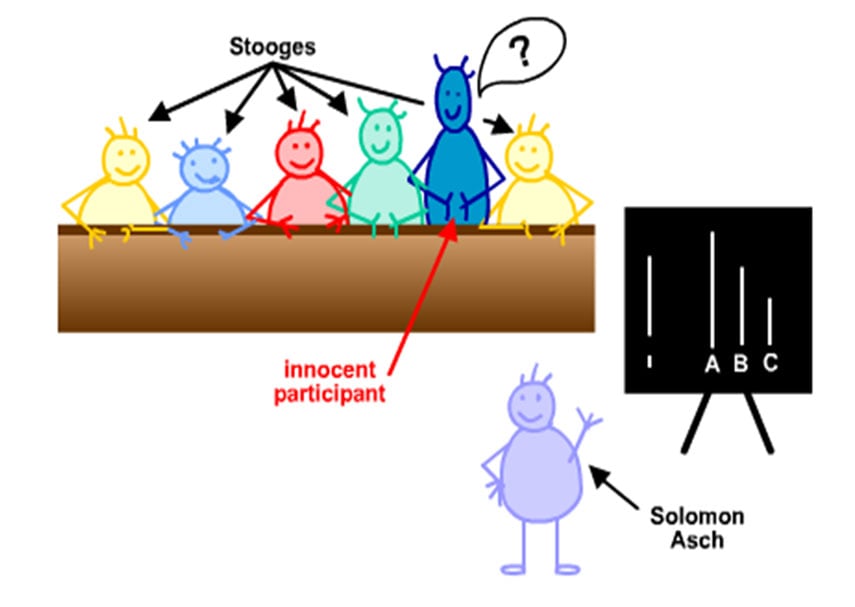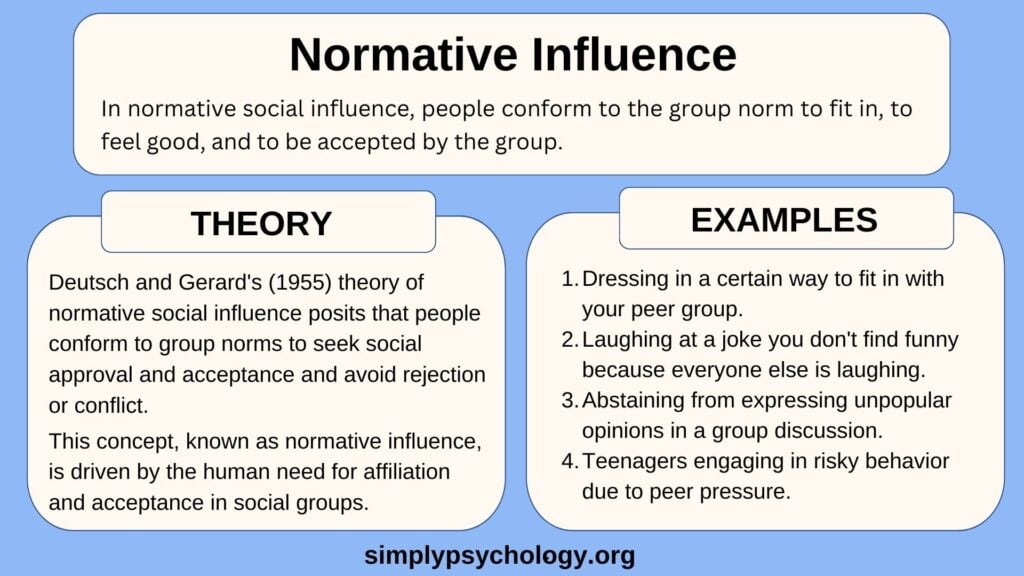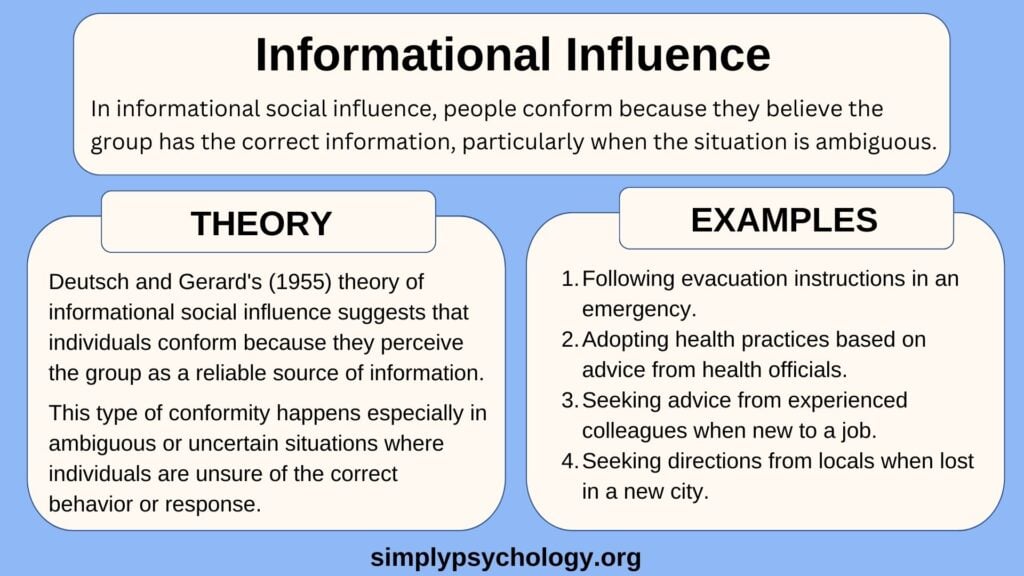On This Page:
Deutsch and Gerrard (1955) identified two reasons why people conform:
- Normative social influence prompts individuals to conform to group norms to fit in, gain acceptance, and feel good.
- Informational social influence leads people to conform, believing the group possesses competent and correct information, especially in ambiguous situations or tasks.
Normative Influence
Normative social influence is where a person conforms to fit in with the group because they don’t want to appear foolish or be left out.
The person conforms to group pressure because they are scared of being rejected by the group.
Normative social influence is usually associated with compliance, where a person changes their public behavior but not their private beliefs. This means any change of behavior is temporary.
The human need for affiliation and acceptance in social groups drives normative influence. It can cause individuals to adopt behaviors, attitudes, or values that they might not personally hold to fit in or to avoid disapproval from the group.
This theory plays a fundamental role in understanding group dynamics and social behavior, illustrating how the fear of social rejection can significantly influence individual behaviors and decisions.
Examples
- Peer Pressure: A person may feel pressured to smoke because the rest of their friends are. They conform to the group behavior, not out of personal desire but to gain acceptance and avoid social exclusion. Normative social influence tends to lead to compliance because the person smokes just for show, but deep down, they wish not to smoke.
- Fashion Trends: When people follow fashion trends that they don’t necessarily like, it shows the desire to fit in with societal expectations and the fear of standing out or being viewed as different, key aspects of normative social influence.
- Social Media Likes: The trend of posting content on social media that aligns with popular sentiment, even if it doesn’t reflect one’s true opinion, demonstrates the power of normative social influence, as individuals modify their behavior to meet the expectations of the online community and gain social approval.
Asch Line Study
In the experiment, participants were shown a target line and asked to select the line (out of three options) that matched its length.

However, each group was mostly comprised of confederates of the experimenter who intentionally selected the wrong line. The actual participant was placed last or near the end in the order of responses.
Despite the obvious answer, Asch found many participants conformed to the incorrect majority answer.
Even though participants knew the group’s choice was incorrect, they conformed to avoid the discomfort of disagreeing with the group or standing out.
When the participants were interviewed after the experiment, most said that they did not believe their conforming answers but had gone along with the group for fear of being ridiculed or thought “peculiar.
This study demonstrated the power of normative influence, as individuals were willing to contradict their senses to conform to the group.
Informational Influence
Informational social influence refers to the tendency to conform to what others are doing or saying because we perceive them as a source of accurate information, particularly in ambiguous or uncertain situations.
Informational social influence is where a person conforms because they have the desire to be right and look to others who they believe may have more information. People may experience an ambiguous (i.e., unclear) situation and socially compare their behavior with the group.
This type of conformity occurs when a person is unsure of a situation or lacks knowledge and is associated with internalization. This theory highlights how the desire to make correct or appropriate decisions can lead to social conformity.
Individuals publicly change their behavior to fit in with the group while agreeing with them privately. An internal (private) and external (public) change of behavior.
This is the deepest level of conformity, where the group’s beliefs become part of the individual’s belief system.
Examples
- Ambiguous Situations: An example of this is if someone was to go to a posh restaurant for the first time, they might be confronted with several forks and not know which one to use, so they might look to a nearby person to see what fork to use first.
- Emergency Situations: In emergencies, people often look to others to determine how to respond. If everyone else is calm, a person is likely to conclude that the situation isn’t serious, whereas if people are panicking, the person will likely perceive the situation as serious.
- Public Health Crises: During public health crises, people often rely on information from health officials, government leaders, and peers to determine how to protect themselves, reflecting informational social influence.
- Asking for Directions: When lost, people usually ask locals for directions as they are assumed to have accurate information about the area.
- Learning a New Job: When starting a new job, people often look to coworkers for cues on how to behave, especially when unsure of the rules or expectations.
Sherif’s Autokinetic Effect Experiment
In this classic study, participants were shown a stationary pinpoint of light in a dark room and asked to estimate how far the light moved.
When individuals made estimates in a group, their estimates converged, illustrating informational social influence as they used others’ estimates as a guide in an ambiguous situation.
Jenness’ Bean Jar Experiment
Jenness conducted a study on conformity where participants were asked to estimate the number of beans in a jar. Initially, each participant made an individual estimate, and then, they estimated it as a group.
His findings indicated that when the task was performed within a social group, participants’ estimates converged to a similar value, despite their initial individual estimates varying significantly.
This study effectively demonstrated the influence of the majority, proving that a group can impact individuals’ behaviors and beliefs.
This is likely an instance of informational social influence, as participants would be unsure about the actual number of beans in the jar.
Learning Check
Here are some real-life examples of conformity. For each one, identify the type of conformity that is happening. You should try to explain your answers.
- Sam has just started work in an office. On his second day there, his colleagues discussed asylum seekers coming to the UK. His colleagues thought that they received favorable treatment from the government and that this should stop. Sam doesn’t agree with this view, but when asked what he thought, he said his colleagues were right.
- Parvinder is a police officer. Her friends have remarked that when she is off duty, she is a relaxed and easygoing person, but when she is in uniform, she becomes much more serious and authoritative. It’s almost as if she was two different people.
- Emma is a student. When she first went to university, she made friends with a group of students who were passionate about animal rights. Emma didn’t have strong opinions on animal research then, but over the past few months, she has become very much against it. Now she has joined a campaign against animal research and has started attending public demonstrations with her friends.
- It is Jim’s first day of college, but he arrived late and missed the part where a lecturer told all the new students what they should do during induction. He sees a group of students filing off towards a corridor and decides to follow them.
- Jan and Norah have just finished their first year at university, living in a house with six other students. All the other students were very health conscious and ate only organic food. Jan had listened to their point of view, and now she also eats only organic food.
- Norah was happy to eat organic food while in the house, but when she went home for the holidays she ate whatever her mother cooked. Both girls conformed but for different reasons. Explain which type of conformity each girl was showing.


References
Asch, S. E. (1951). Effects of group pressure upon the modification and distortion of judgment. In H. Guetzkow (ed.) Groups, leadership and men. Pittsburgh, PA: Carnegie Press.
Deutsch, M., & Gerard, H. B. (1955). A study of normative and informational social influences upon individual judgment. The Journal of Abnormal and Social Psychology, 51(3), 629.
Jenness, A. (1932). The role of discussion in changing opinion regarding a matter of fact. The Journal of Abnormal and Social Psychology, 27, 279-296.
Sherif, M. (1935). A study of some social factors in perception. Archives of Psychology, 27(187).

